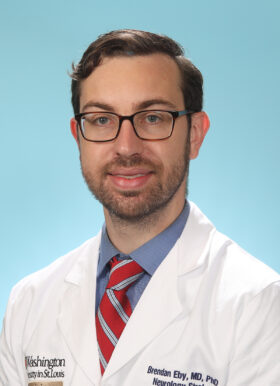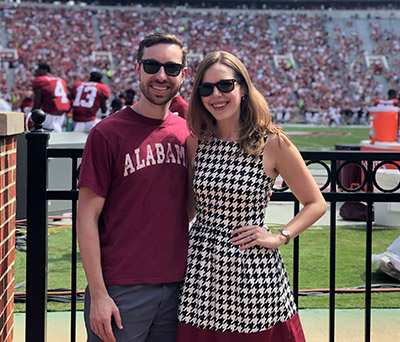Brendan Eby, MD

Brendan Eby, MD is a neurologist who sees patients for neuroendovascular surgery (minimally invasive treatment of cerebrovascular abnormalities), cerebral aneurysms, cerebral arteriovenous malformations (AVMS) and fistulas (AVFs), carotid stenosis and carotid stenting, ischemic stroke.
Please call 314-362-7382 to make an appointment
What happened in the course of schooling to influence you to choose your specialty?
Early on in medical school, I realized I was interested in the brain. However, I had difficulty deciding between neurology and neurosurgery, and ultimately went with neurology. Towards the end of medical school I witnessed a neurosurgeon perform a thrombectomy (minimally invasive surgical procedure that removes a blood clot from an artery) on an acute stroke patient. It was incredible.
Subsequently, I learned that there were pathways to interventional neurology or neuroendovascular surgery from many different routes, including neurology. At that point, I realized this might be a great way to blend my interests through neurology and be able to explore both full medicine and diagnosis, as well as the surgical aspects of the specialty.
My primary specialty is neurology. But my fellowships (advanced training) are in vascular neurology and interventional neurology or neuroendovascular surgery. So, my subspecialty is the blend of three different fields — neurology, neurosurgery and radiology.
What brought you to Washington University?
My wife and I actually did our residency training here — so you could say the “couples match” for residency brought us here. We were looking for excellence in training at a high-end academic center, and were both fortunate to secure training spots here at Washington University.
After four years here, we spent three years at Emory University in Atlanta, GA for fellowship training. After our fellowships, we both had the opportunity to return to Washington University. We were eager to come back as it held a special place in our hearts.
I was also excited to return because I am the first neurologist to join the neuroendovascular surgery group (interventional neuroradiology group). They had not had representation from our department before.

Which aspect of your practice is most interesting?
What is most unique and interesting about this field, particularly the interventional aspect, is it blends three different specialties (neurology, neurosurgery and radiology). My colleagues are highly trained neurosurgeons and radiologists, and we all bring a slightly different view and background to the table. This combination helps push advancements in technology, patient care and patient outcome — more than if you just had one voice in the room. Being able to bridge the gap between all of these specialties, makes it particularly unique.
The main focus of my specialty includes treatments through minimally invasive catheter-based procedures. Because ischemic stroke is a very prevalent disease, it is the most common condition I see, and is the area in which I have advanced training. There are so many people who have strokes, it is important for them to have access to immediate treatment.
This leads to the reason we are adding a thrombectomy capable center in Barnes-Jewish-St. Peters Hospital. Currently, there are only a handful of hospitals in St. Louis, and none in St. Charles County, that perform thrombectomies. This new center will give us the tools to treat stroke closer to home for those living in the St. Charles area.
What is the difference between an ischemic stroke and a cerebral aneurysm?
An ischemic stroke is a blockage in an artery, and can cause sudden onset weakness, numbness – particularly on one side of the body. Using the catheter procedure, we try to find and pull out the blood clot, and in order to save some of the brain that might be dying from the blocked artery.
An aneurysm is an abnormality of the wall of the artery — a ballooning or bulging out. The risk is that the aneurysm can burst and bleed. Most people experience a really bad headache, but it can cause a lot of complications as the body tries to break down the blood.
The treatment differs for these two conditions. For strokes, we actually pull out the blood clot. The treatment for aneurysm is to fill the artery with soft metal coils or place a stent across it to prevent bleeding.
What new developments in your field are you most excited about?
There are so many new developments, it is really hard to pinpoint one. When it comes to ischemic stroke, it has only been in the last five to six years we’ve proven catheter treatments to be successful in clearing the clot. The technology is advancing constantly, and companies continue to develop better catheters to make us more effective and faster at opening up the arteries.
Another new development for treating aneurysms is an intrasaccular device. The device sits inside the aneurysm sac, and blocks off the aneurysm.
Robotics are also on the horizon, but not ready for prime time yet. Using a robot during a catheter procedure, may make it more precise, but will also decrease the amount of radiation for everyone in the room – because all of my procedures are under X-ray.
In the future, robotics will also make is possible to do catheter procedures remotely – with a patient in one location and the doctor in another. But we are still in the early, fledgling stages of that advancement.
Where are you from?
I’m a proud product of the state of Alabama, originally from Birmingham. I went through high school there, University of Alabama for my undergraduate, and University of Alabama School of Medicine in Birmingham. That is where I met my wife. She is from just outside Chicago, in northwest Indiana. That was part of our draw coming up to the Midwest for residency — and now to settle into our careers here. My wife is a pediatric emergency medicine physician at St. Louis Children’s Hospital.
Which particular award or achievement is most gratifying?
I’ve received a few teaching awards through my training, and those are the ones of which I am most proud. The first was The Irwin Levy Residency Teaching Award – for outstanding teaching by a resident. And as a vascular neurology fellow, I received the Neurology Best Fellow teaching award.
Teaching is a really important part of the role of any physician, but especially one in an academic center when you are working with junior physicians and residents.
Whether it is teaching your patients about their disease so they can help manage it better. Or training the next generation of doctors so they can discover advancements in our field.
Coming to a teaching hospital was certainly part of the draw for me. I look forward to becoming a mentor and exposing residents to this exciting field — teaching what I do and how to take care of our patients.
What is the best advice you’ve received?
There was one piece of advice that really stood out. It’s hard for me to remember exactly who said it, but I believe it was a nurse practitioner during my residency. It had been a particularly hard and frustrating day in the neuro intensive care unit. This nurse practitioner, who had many years of experience, said to me, “Remember, when you are seeing a patient or a family member, it is the worst day of their life. It might be just another day on the job for you, but for them, it is the worst day of their life.”
That put everything into perspective for me. When we are called into the emergency room in the middle of the night to do a procedure, or if it is another difficult day and everyone is tired, I share this advice to remind everyone and myself this is a true emergency, and is why we do what we do.
If you weren’t a doctor, what would you like to be doing?
This is a difficult question, because I always wanted to be a doctor. I find computer engineering really interesting — the technology and the gadgets are super exciting. I’m inspired by my younger brother who is a computer engineer, and I’m a bit jealous of the fun things he gets to do. If I had to choose another career, computer engineering would be it.